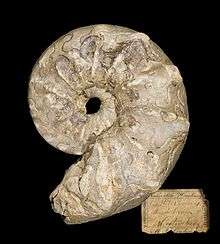Ceratites
Ceratites is an extinct genus of ammonite cephalopods. These nektonic carnivores lived in marine habitats in what is now Europe, Asia, and North America, during the Triassic, from Anisian to Ladinian age.[2]
| Ceratites | |
|---|---|
 | |
| Ceratites nodosus Upper Muschelkalk - Germany | |
| Scientific classification | |
| Kingdom: | |
| Phylum: | |
| Class: | |
| Subclass: | |
| Order: | |
| Superfamily: | |
| Family: | |
| Subfamily: | Ceratitinae |
| Genus: | Ceratites de Haan (1825) |
| |
Description
This ammonite has a ceratitic suture pattern on its shell (smooth lobes and frilly saddles). Evolution of the frilly saddles is thought to be due to increased pressure on the shell, at greater depth. The frilly pattern would increase the strength of the shell and allow Ceratites to dive deeper, possibly in search of food.
Distribution
Fossils of species within this family have been found in the Triassic of Austria, Canada, China, France, Germany, Hungary, India, Israel, Italy, Pakistan, Poland, Russia, Thailand, Turkey and United States.[3]
gollark: In the sense that "it's bad, but not enough for it to matter much unless you need to optimise that bit"?
gollark: This is merely an issue due to C bad.
gollark: You can shrink them to fit if needed and it is almost certainly better timewise than the alternative.
gollark: Reallocing constantly MAY be !inefficient!!.
gollark: The superior rust ones double their capacity when they fill up.
References
- Triassic ammonoid biostratigraphy: an overview. Marco Balini, Spencer G. Lucas, James F. Jenks and Justin A. Spielmann, Geological Society, London, Special Publications 2010, volume 334, pages 221-262, doi:10.1144/SP334.10
- Sepkoski, Jack Sepkoski's Online Genus Database – Cephalopoda
- The Paleobiology Database
This article is issued from Wikipedia. The text is licensed under Creative Commons - Attribution - Sharealike. Additional terms may apply for the media files.